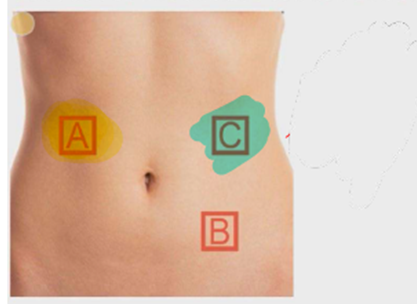A nurse is collecting data from a client who is postoperative following placement of a colostomy in the ascending colon. In which of the following locations should the nurse expect to find the stoma?

A
B
C
The Correct Answer is A
A. Right upper quadrant is correct. A colostomy placed in the ascending colon is typically located in the right upper quadrant of the abdomen. The ascending colon runs along the right side of the abdomen, so the stoma will be located in that region.
B. Left lower quadrant is incorrect. The left lower quadrant is typically where the descending colon or sigmoid colon are located, so a colostomy placed here would be for those regions, not the ascending colon.
C. Left upper quadrant is incorrect. The left upper quadrant contains parts of the stomach, spleen, and pancreas, but not the ascending colon. A colostomy in the ascending colon would not be located here.
Nursing Test Bank
Naxlex Comprehensive Predictor Exams
Related Questions
Correct Answer is B
Explanation
A. An entry on a nursing blog addressing wound healing: Nursing blogs can offer personal perspectives and experiences but may not always be evidence-based. The information can vary in quality and credibility.
B. A peer-reviewed journal article: This is correct. Peer-reviewed journal articles are the gold standard for evidence-based information because they have been evaluated by experts in the field and provide scientifically validated information.
C. First-hand experience with wound care products: While first-hand experience can be valuable, it is subjective and may not reflect the most current or broad evidence-based practices. It should be supplemented with research.
D. Information from a wound care product vendor: Although vendors may offer useful product-specific details, their information is often biased toward their own products and may not provide the most objective, evidence-based information available.
Correct Answer is B
Explanation
A. Encourage the client to soak in a hot bath.: While a warm bath can help alleviate muscle tension and discomfort, it is not recommended during the latent phase of labor due to the potential for increasing the risk of infection, especially if the membranes are ruptured.
B. Instruct the client to change positions frequently.: Frequent position changes during the latent stage of labor can help alleviate pelvic pain, improve comfort, and encourage progress in labor. This is a beneficial intervention that promotes movement and comfort without introducing unnecessary risks.
C. Apply fundal pressure during contractions.: Fundal pressure is not appropriate during the latent stage of labor, as it can cause fetal distress or other complications. It is typically avoided unless indicated in more advanced stages of labor under specific circumstances.
D. Tell the client to push during contractions.: Pushing is not recommended during the latent stage of labor. The latent phase involves the cervix gradually dilating, and pushing should be delayed until the active stage of labor when the cervix is fully dilated and ready for delivery.
Whether you are a student looking to ace your exams or a practicing nurse seeking to enhance your expertise , our nursing education contents will empower you with the confidence and competence to make a difference in the lives of patients and become a respected leader in the healthcare field.
Visit Naxlex, invest in your future and unlock endless possibilities with our unparalleled nursing education contents today
Report Wrong Answer on the Current Question
Do you disagree with the answer? If yes, what is your expected answer? Explain.
Kindly be descriptive with the issue you are facing.
